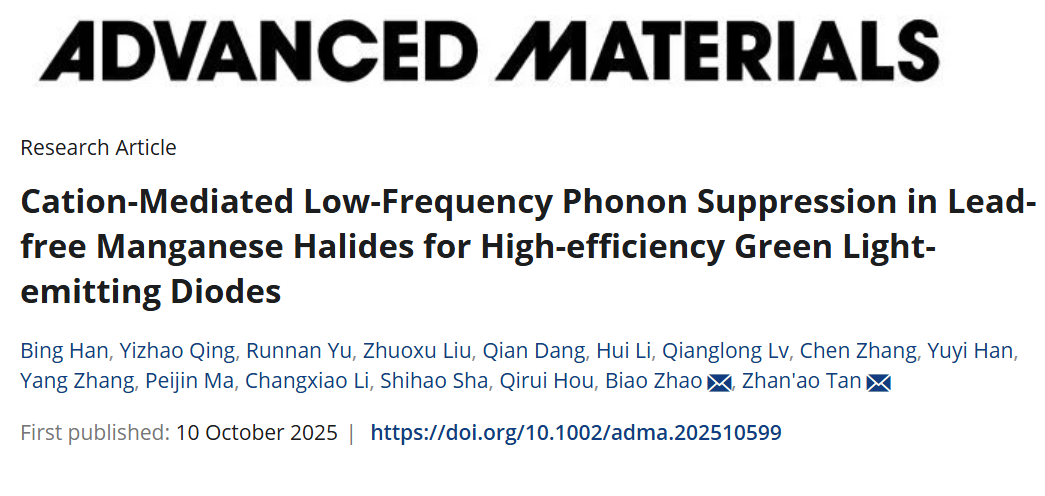
Lead halide perovskites (LHPs) have become a focal point of research in next-generation optoelectronics due to their remarkable properties, including tunable emission wavelengths, extraordinary photoluminescence quantum yields (PLQY), high color purity, efficient charge carrier mobility, intrinsic defect tolerance, and cost-effective solution processability. However, the inherent toxicity of lead raises serious environmental and health concerns. Consequently, lead-free metal halides based on elements such as manganese have been extensively investigated as viable alternatives. Among them, manganese-based metal halides show significant promise for green-emitting applications owing to their narrow emission spectra and high PLQY. Nevertheless, the film formation process of manganese-based halides tends to generate energy-level defects and enhance low-frequency phonon vibrations, which subsequently induce non-radiative recombination and hinder their development in electroluminescent devices. Thus, the key challenge lies in modulating film morphology to reduce defect density and thereby enhance radiative recombination.
Recently, the research group of Prof. Tan Zhan'ao from the State Key Laboratory of Chemical Resource Engineering and Advanced Innovation Center for Soft Matter Science and Engineering innovatively proposed achieving high-efficiency green emission by suppressing cation-mediated low-frequency phonons. By designing dimethylamino-functionalized A-site cations in manganese bromides, they successfully realized synergistic control over phonon dynamics, film morphology, and energy level alignment. This breakthrough has enabled record efficiency in solution-processed green-emitting lead-free metal halide devices.
By introducing one or two dimethylamino (-N(CH3)2) groups onto the benzene ring, the hybrid manganese bromides (PPh4N)2MnBr4 and (PPh4N2)2MnBr4 were successfully synthesized.Compared to (PPh4)2MnBr4 film, (PPh4N)2MnBr4 film displayed a significantly enhanced PLQY of 70.44%, attributed to the following three aspects. First, the methyl groups of -N(CH3)2 enhances the solution-processability of hybrid manganese bromides, reducing grain boundaries and flattening film surface. This leads to decreased trap density in emissive layers. Second, p-π conjugation increases rigidity of benzene rings in A-site cations, which increase the frequency and reduce the amplitude of out-of-plane twisting modes of benzene rings. Third, appropriate -N(CH3)2 attachment weakens van der Waals force between A-site cations and surrounding lattice, which reduces electron-phonon coupling and phonon density of states related to A-site cations. As a result, multi-phonon nonradiative recombination in A-site cations are effectively suppressed. In addition to the modifications in photophysical properties, the electron-donating - N(CH3)2 groups and the electron-withdrawing phosphonium cation established a donor-acceptor structure with the benzene ring, which effectively narrowed the bandgap of PPh4+ and improved energy band alignment in electroluminescent devices.
LEDs fabricated from undoped (PPh4N)2MnBr4 and (PPh4N2)2MnBr4 exhibited improved performance metrics, particularly in EQEmax (9.1% and 7.5%) and maximum luminescence (Lmax=2056 cd m-2and 1500 cd m-2). Furthermore, when doped with 9-(4-tert-butylphenyl)-3,6-bis(triphenylsilyl)-9H-carbazole (CzSi), the device performance of (PPh4N)2MnBr4 reached an EQEmax of 12.0% and Lmax of 6169 cd m-2, marking the highest efficiency value reported for solution-processed green lead-free metal halide electroluminescent devices. Moreover, large-area electroluminescent devices of (PPh4N)2MnBr4 were fabricated in air using the blade-coating method, highlighting its potential for display applications.
The related work, titled “Cation-mediated low-frequency phonon suppression in lead-free manganese halides for high-efficiency green light-emitting diodes” is published in Advanced Materials. The first author is Bing Han and Yizhao Qing, PhD. students from the State Key Laboratory of Chemical Resource Engineering and Advanced Innovation Center for Soft Matter Science and Engineering. Prof. Zhan’ao Tan and Dr. Biao Zhao are the co-corresponding authors. This research was supported by the Beijing Natural Science Foundation and State Key Laboratory of Chemical Resource Engineering.
Article Information::
Bing Han, Yizhao Qing, Runnan Yu, Zhuoxu Liu, Qian Dang, Hui Li, Qianglong Lv, Chen Zhang, Yuyi Han, Yang Zhang, Peijin Ma, Changxiao Li, Shihao Sha, Qirui Hou, Biao Zhao*, Zhan’ao Tan*, Cation-mediated low-frequency phonon suppression in lead-free manganese halides for high-efficiency green light-emitting diodes. Adv. Mater. 2025:e10599.
Original Article Link:https://doi.org/10.1002/adma.202510599